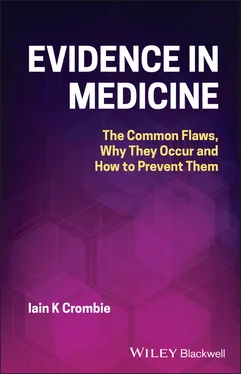66 66. Berger, V.W. (2017). Subjecting known facts to flawed empirical testing. J. Clin. Epidemiol. 84: 188.
67 67. Rainville, T., Laskine, M., and Durand, M. (2019). Use of modified intention‐to‐treat analysis in studies of direct oral anticoagulants and risk of selection bias: a systematic review. BMJ Evid. Based Med. 24: 63–69.
68 68. Farquhar, C.M., Showell, M.G., Showell, E.A.E. et al. (2017). Clinical trial registration was not an indicator for low risk of bias. J. Clin. Epidemiol. 84: 47–53.
69 69. Trinquart, L., Dunn, A.G., and Bourgeois, F.T. (2018). Registration of published randomized trials: a systematic review and meta‐analysis. BMC Med. https://doi.org/10.1186/s12916‐018‐1168‐6.
70 70. Odutayo, A., Emdin, C.A., Hsiao, A.J. et al. (2017). Association between trial registration and positive study findings: cross sectional study (epidemiological study of randomized trials‐ESORT). BMJ https://doi.org/10.1136/bmj.j917.
71 71. Dechartres, A., Ravaud, P., Atal, I. et al. (2016). Association between trial registration and treatment effect estimates: a meta‐epidemiological study. BMC Med. https://doi.org/10.1186/s12916‐016‐0639‐x.
72 72. Nuesch, E., Trelle, S., Reichenbach, S. et al. (2010). Small study effects in meta‐analyses of osteoarthritis trials: meta‐epidemiological study. BMJ https://doi.org/10.1136/bmj.c3515.
73 73. Dechartres, A., Trinquart, L., Boutron, I. et al. (2013). Influence of trial sample size on treatment effect estimates: meta‐epidemiological study. BMJ https://doi.org/10.1136/bmj.f2304.
74 74. Papageorgiou, S.N., Antonoglou, G.N., Tsiranidou, E. et al. (2014). Bias and small‐study effects influence treatment effect estimates: a meta‐epidemiological study in oral medicine. J. Clin. Epidemiol. 67: 984–992.
75 75. Pereira, T.V., Horwitz, R.I., and Ioannidis, J.P. (2012). Empirical evaluation of very large treatment effects of medical interventions. JAMA 308: 1676–1684.
76 76. Wang, Z., Alahdab, F., Almasri, J. et al. (2016). Early studies reported extreme findings with large variability: a meta‐epidemiologic study in the field of endocrinology. J. Clin. Epidemiol. 72: 27–32.
77 77. Gartlehner, G., Dobrescu, A., Evans, T.S. et al. (2016). Average effect estimates remain similar as evidence evolves from single trials to high‐quality bodies of evidence: a meta‐epidemiologic study. J. Clin. Epidemiol. 69: 16–22.
78 78. Ioannidis, J.P. (2005). Contradicted and initially stronger effects in highly cited clinical research. JAMA 294: 218–228.
79 79. Ingre, M. (2013). Why small low‐powered studies are worse than large high‐powered studies and how to protect against “trivial” findings in research: comment on Friston (2012). NeuroImage 81: 496–498.
80 80. Walsh, M., Srinathan, S.K., McAuley, D.F. et al. (2014). The statistical significance of randomized controlled trial results is frequently fragile: a case for a fragility index. J. Clin. Epidemiol. 67: 622–628.
81 81. Ridgeon, E.E., Young, P.J., Bellomo, R. et al. (2016). The fragility index in multicenter randomized controlled critical care trials. Crit. Care Med. 44: 1278–1284.
82 82. Noel, C.W., McMullen, C., Yao, C. et al. (2018). The fragility of statistically significant findings from randomized trials in head and neck surgery. Laryngoscope 128: 2094–2100.
83 83. Evaniew, N., Files, C., Smith, C. et al. (2015). The fragility of statistically significant findings from randomized trials in spine surgery: a systematic survey. Spine J. 15: 2188–2197.
84 84. Mazzinari, G., Ball, L., Serpa Neto, A. et al. (2018). The fragility of statistically significant findings in randomised controlled anaesthesiology trials: systematic review of the medical literature. Br. J. Anaesth. 120: 935–941.
85 85. Edwards, E., Wayant, C., Besas, J. et al. (2018). How fragile are clinical trial outcomes that support the CHEST clinical practice guidelines for VTE? Chest 154: 512–520.
86 86. Lamberink, H.J., Otte, W.M., Sinke, M.R.T. et al. (2018). Statistical power of clinical trials increased while effect size remained stable: an empirical analysis of 136,212 clinical trials between 1975 and 2014. J. Clin. Epidemiol. 102: 123–128.
87 87. Colquhoun, D. (2014). An investigation of the false discovery rate and the misinterpretation of p‐values. R. Soc. Open Sci. https://doi.org/10.1098/rsos.140216.
88 88. IntHout, J., Ioannidis, J.P., Borm, G.F. et al. (2015). Small studies are more heterogeneous than large ones: a meta‐meta‐analysis. J. Clin. Epidemiol. 68: 860–869.
89 89. Froud, R., Rajendran, D., Patel, S. et al. (2017). The power of low Back pain trials: a systematic review of power, sample size, and reporting of sample size calculations over time, in trials published between 1980 and 2012. Spine 42: E680–E686.
90 90. Azad, T.D., Veeravagu, A., Mittal, V. et al. (2018). Neurosurgical randomized controlled trials‐distance travelled. Neurosurgery 82: 604–612.
91 91. Gan, H.K., You, B., Pond, G.R. et al. (2012). Assumptions of expected benefits in randomized phase III trials evaluating systemic treatments for cancer. J. Natl. Cancer Inst. 104: 590–598.
92 92. Matheson, A. (2017). Marketing trials, marketing tricks – how to spot them and how to stop them. Trials https://doi.org/10.1186/s13063‐017‐1827‐5.
93 93. Lundh, A., Lexchin, J., Mintzes, B. et al. (2018). Industry sponsorship and research outcome: systematic review with meta‐analysis. Intensive Care Med. 44: 1603–1612.
94 94. Riaz, H., Raza, S., Khan, M.S. et al. (2015). Impact of funding source on clinical trial results including cardiovascular outcome trials. Am. J. Cardiol. 116: 1944–1947.
95 95. Sismondo, S. (2008). Pharmaceutical company funding and its consequences: a qualitative systematic review. Contemp. Clin. Trials 29: 109–113.
96 96. Sturmberg, J.P. (2019). From probability to believability. J. Eval. Clin. Pract. 26: 1081–1086.
97 97. Smith, R. (2005). Medical journals are an extension of the marketing arm of pharmaceutical companies. PLoS Med. https://doi.org/10.1371/journal.pmed.0020138.
98 98. Pyke, S., Julious, S.A., Day, S. et al. (2011). The potential for bias in reporting of industry‐sponsored clinical trials. Pharm. Stat. 10: 74–79.
99 99. Zwierzyna, M., Davies, M., Hingorani, A.D. et al. (2018). Clinical trial design and dissemination: comprehensive analysis of http://clinicaltrials.govand PubMed data since 2005. BMJ https://doi.org/10.1136/bmj.k2130.
100 100. Rasmussen, K., Bero, L., Redberg, R. et al. (2018). Collaboration between academics and industry in clinical trials: cross sectional study of publications and survey of lead academic authors. BMJ https://doi.org/10.1136/bmj.k3654.
101 101. Lexchin, J. (2012). Those who have the gold make the evidence: how the pharmaceutical industry biases the outcomes of clinical trials of medications. Sci. Eng. Ethics 18: 247–261.
102 102. Dunn, A.G., Bourgeois, F.T., and Coiera, E. (2013). Industry influence in evidence production. J. Epidemiol. Community Health 67: 537–538.
103 103. Every‐Palmer, S. and Howick, J. (2014). How evidence‐based medicine is failing due to biased trials and selective publication. J. Eval. Clin. Pract. 20: 908–914.
104 104. Flacco, M.E., Manzoli, L., Boccia, S. et al. (2015). Head‐to‐head randomized trials are mostly industry sponsored and almost always favor the industry sponsor. J. Clin. Epidemiol. 68: 811–820.
105 105. Spielmans, G.I. and Parry, P.I. (2010). From evidence‐based medicine to marketing‐based medicine: evidence from internal industry documents. J. Bioethic Inquiry 7: 13–29.
106 106. Ioannidis, J.P.A. (2018). Randomized controlled trials: often flawed, mostly useless, clearly indispensable: a commentary on Deaton and cartwright. Soc. Sci. Med. 210: 53–56.
Читать дальше












